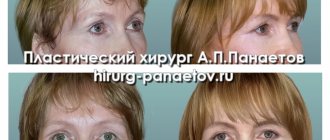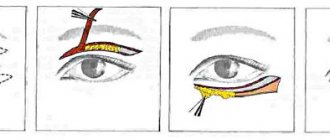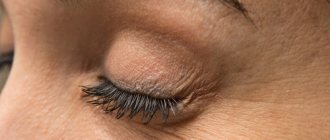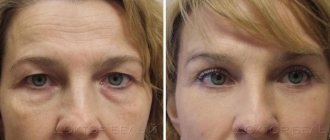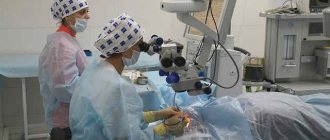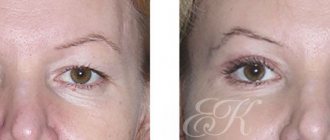The condition of the eyelids and skin around the eyes determines a person’s appearance and reveals his age. Wrinkles, drooping corners of the eyes, sagging eyelids - all these imperfections negatively affect one's appearance. For the purpose of aesthetic or medical correction of this area, canthoplasty and canthopexy are performed. What is their difference, we will tell you in the article.
Canthopexy and canthoplasty are plastic surgeries in the corners of the eyes. They can be carried out both for the purpose of aesthetic correction of appearance (changing the shape of the eyes, tightening the skin) and for medical purposes. There are several indications for performing canthoplasty and canthopexy:
- wrinkles around the eyes and other signs of aging;
- asymmetrical position of the palpebral fissures;
- scars and other consequences of injuries or unsuccessful operations;
- “bags” under the eyes;
- drooping corners of the eyes, giving the face a “sorrowful” look;
- bulging eyes effect;
- eversion of eyelids;
- blepharophimosis;
- pronounced roundness of the eyes.
Like any surgical intervention, canthoplasty and canthopexy have a number of contraindications. These include oncological diseases, diabetes mellitus, infectious-inflammatory process, problems with blood clotting, some ophthalmopathologies, acute forms of chronic diseases and a number of others. The doctor must decide on the advisability and admissibility of surgery on the corners of the eyes and lower eyelids after a thorough history taking and diagnostic examination.
The importance of canthoplasty in comprehensive facial rejuvenation
In recent years, aesthetic medicine has seen an active revision of the fundamental principles of surgical correction of age-related changes in the face and neck.
If ten years ago the foundation of facial plastic surgery was a superficial circular lift and classic blepharoplasty, today the vector has shifted towards deep rejuvenation of the face and neck at the level of the SMAS aponeurosis, periorbitoplasty and contour modeling by changing the bone structures of the facial skeleton (chin, zygomatic region). Canthoplasty is a clear illustration of the changes that are taking place in global plastic surgery today. We can consider the operation separately, as a surgical tightening of the lateral (less often medial) corner of the eyelid, but it would be more correct to look at canthopexy in the context of periorbitoplasty, the purpose of which is radical rejuvenation of the entire area around the eyes, which includes the eyebrows, upper and lower eyelids, lacrimal grooves and soft tissues of the zygomatic region.
Canthopexy of the eyelid plays a very important role in this complex of surgical procedures. A seemingly insignificant change - moving the lateral corner of the eyelid upward and fixing it in an elevated position - has a tremendous impact on the aesthetics of the face. Raised corners of the eyes are associated with good mood, youth and well-being. They are indicators of health, positive thinking, self-confidence and success.
Plastic surgeons highlight another point of application for canthoplasty. By minimally changing the position of the lateral corner of the eyelid, we significantly change the angle of the palpebral fissure, and at the same time its inclination, width and shape. If, due to age-related changes, the palpebral fissure has acquired a rounded shape, and the corner of the eye has lost its youthful sharpness, canthoplasty solves this aesthetic problem. It allows you to correct the inclination of the palpebral fissure and form an almond-shaped eye shape that corresponds to the classical canons of beauty.
Canthoplasty also affects the aesthetics of the lower eyelid. Sagging eyelids caused by involutional processes cannot always be corrected using classic transconjunctival blepharoplasty. Moreover, blepharoplasty can lead to eversion of the eyelid, which only worsens the defect. Canthopexy makes it possible to prevent lower eyelid prolapse, eliminate an existing defect, or correct the consequences of unsuccessful blepharoplasty.
Most common complications
- Wound infection with subsequent development of inflammation
- Rough scarring at the incision site.
These are low-traumatic interventions, so these complications rarely occur. You just need to follow all the doctor’s recommendations in the postoperative period. Do not forget to take antibiotics in the first 7-10 days, use special local medications recommended by the surgeon, visit the Clinic regularly for routine examinations prescribed by the doctor, then the above problems, of course, will not arise.
In addition, the doctors of the SOLEI Plastic and Aesthetic Surgery Clinic are highly qualified specialists in their field, so you can rest assured about the technique of performing the operation. Canthopexy will help you achieve the desired eye shape for yourself and those around you. Reviews about it can be seen on a large number of sites, including ours.
Canthopexy of the eyelid: indications
After a detailed analysis of the possibilities of eyelid canthopexy and its significance in the complex of surgical procedures aimed at facial rejuvenation, we can only draw an intermediate conclusion. Let us once again highlight the goals of canthoplasty and indications for this rejuvenating operation.
The purpose of canthopexy and canthoplasty is to correct the position of the outer corner of the eye, the shape of the eye section, the width and inclination of the palpebral fissure.
Canthopexy and canthoplasty are performed for the following indications:
- Downward displacement of the lateral corners of the eyelids
- Age-related rounding of the outer corner of the eye
- Changes in the inclination and width of the palpebral fissure
- Sagging lower eyelid
Contraindications
- oncopathology;
- diabetes;
- general infections in the body;
- blood clotting disorder;
- pregnancy and breastfeeding;
- various eye pathologies, including increased intraocular pressure;
- increased blood pressure;
- chronic diseases in acute form;
- inflammation in the intended intervention area;
- age under 18 years;
- dry eye syndrome;
- myopia.
Memo for preparing for blepharoplasty: tests, prohibitions, recommendations
Preoperative examinations before blepharoplasty
Canthopexy and canthoplasty: features of operations
Throughout this material, we have used the terms canthopexy and canthoplasty as synonyms. This is explained by the fact that, from the point of view of the tasks being solved, there are few differences between the operations. The differences relate to the surgical techniques used during the correction.
With canthopexy, the canthal tendon is tightened, that is, the tendon that fixes the lateral angle of the eyelid (canthus) to the bone structures. With canthoplasty, the lift can be supplemented by excision of excess soft tissue - fragments of stretched tendon and/or skin.
Reviews
For a long time I could not decide on canthoplasty, although I had heard about it for a long time. Since my youth, I have not been satisfied with my eye shape. And with age, the corners of the eyes began to droop a little. I didn’t want to look at myself in the mirror, not only because of the wrinkles that were appearing, but also because the shape of my eyes was changing for the worse.
A couple of months ago, my friend had canthoplasty. The effect surprised me extremely positively... After looking at her, I also turned to the plastic surgery center, however, not in Moscow, but in Podolsk. After consulting a surgeon, I finally realized that my time had come. I’ll say right away that the price does not correspond to the quality, since the quality is much HIGHER than the small price of the operation))) The whole manipulation lasted about a little over an hour.
I was afraid that after the operation I would have severe swelling and bruising, and I was worried that I would not be able to go to work for a long time. However, my doctor performed the plastic surgery so carefully and expertly that my swelling was very small and the bruises were barely noticeable. Canthoplasty is a godsend at a certain age, as I already understand.
Natalya, 45 years old, Moscow
Several years ago, I began to engage in self-development, read literature on personal growth, and took care of myself. She strived to improve relationships with others and become a successful person. In addition to personal attitudes, I decided to change my visual appearance. I bought new clothes and cosmetics. And you know... I realized that I wanted some radical changes in my appearance. On websites about plastic surgery and cosmetology, I saw that there is such a type of operation as canthoplasty, which can change the shape of the eyes, removing hints of the past years. I immediately caught fire and realized that this was exactly the change I wanted in my appearance, and canthoplasty would help me with this. Before and after it, I look completely different. The shape of my eyes became, as promised, almond-shaped, the folds and “bags” on the eyelids disappeared, since the doctor combined the operation in my case with blepharoplasty of the lower eyelids. Now I am 100 percent happy with my face and do not regret at all that I had this operation. For those who have doubts or have not yet decided, I highly recommend both the clinic and the surgeon Sergei Anatolyevich.
Olga, 47 years old, Tver
My husband works as a surgeon in a hospital with children. It was he who told me that there is canthoplasty, which can make me even more beautiful in his opinion...)) He told me the whole essence of it, which is why I did not hesitate for a long time. In addition, the cost is not so high compared to the result. There are no complaints about my surgeon, Dr. Demin S.N., to whom my husband brought me, using the recommendations of doctor friends, he did everything perfectly, explained how to behave after I leave the clinic, what regimen to follow. Six months have passed, and the result continues to please me and my husband.
Maria, 36 years old, Klimovsk
What operations are canthoplasty performed with?
Of course, lifting the lateral corner of the eye can be an independent procedure, but more often it is performed as part of a comprehensive rejuvenation of the upper and middle third of the face. To eliminate age-related imperfections of the upper eyelid, upper blepharoplasty is performed, as well as endoscopic lifting of the eyebrows and skin of the frontal area, which has a huge impact on the aesthetics of the entire upper third of the face. To enhance the aesthetic effect, the location of the upper eyelid crease can be corrected.
Elimination of age-related manifestations on the lower eyelids and in the zygomatic region is performed as part of lower blepharoplasty. Lower eyelid plastic surgery is increasingly being combined with check-lifting, which allows eliminating malar edema of the zygomatic region, moving the deep tissues of the middle third upward and reducing the severity of tear troughs.
You can learn more about the latest approaches to deep facial rejuvenation at a consultation with a plastic surgeon at the Moscow SOHO CLINIC medical center. Sign up for a consultation and learn about all the possibilities of modern aesthetic medicine!
Canthopexy technique
Having decided on the indications, the surgeon must decide what kind of plastic surgery is necessary in this case - only canthopexy of the lower eyelids or canthopexy with blepharoplasty.
Let's talk about lateral canthopexy. It is she who will interest us most of all. In most cases, the procedure can be performed under local anesthesia on an outpatient basis.
If the patient’s case is complex and the intervention is quite extensive, general anesthesia is used. And then after the operation the patient remains under observation from several hours to a day.
Canthopexy in Podolsk at the SOLEI Plastic and Aesthetic Surgery Clinic is carried out within 30 minutes to an hour and a half.
Standard surgical technique:
- The surgeon marks the location of the incision using a marker above the upper eyelid in the area of the outer corner
- Making an incision above the lateral canthus, in a fold of skin that everyone can see, no more than 1 cm long (along the marking line)
- After the incision, the external palpebral ligament becomes accessible, which is responsible for the location of the outer corner of the eye and holds it. Through the incision, the lateral ligament is pulled upward and secured to the periosteum of the orbit using self-absorbing suture material
- After reliable fixation of the lateral tendon, the incision above the upper eyelid is sutured, the wound is treated with an antiseptic and covered with a bandage.
Since the incision is made in the skin above the upper eyelid, the scar remains invisible after canthopexy. Regeneration in this area of the skin usually occurs well.
Cost in Minsk
The final cost of cosmetic surgery is very variable. Its formation depends on many factors, for example, the quality of equipment and materials, personnel qualifications, the number of days spent in the clinic, etc. Taking into account these features, the price for these operations can range from $400 to $600.
When choosing a place for surgery, you need to pay special attention to the choice of the doctor who will perform the operation. It is the qualifications of the surgeon that are of decisive importance in the success of the operation and the compliance of expectations with the stated result.
General information about the procedure
The main objective of canthopexy as a method is to eliminate various anatomical defects (including acquired ones), as well as facial rejuvenation. According to generally accepted indicators of the norm, the edge of the lower eyelid should be located slightly above the lower part of the iris. That is, there should be no white areas under the iris; they should be hidden by the lower eyelid.
If the eyelid is located below the edge of the iris of the eyeball, this is a clear sign of its drooping, which is why aesthetics suffer and various visual impairments may even develop. Considering all that has been said, there are the following indications for canthopexy:
- violation of the anatomical structure due to incorrect positioning of the corner of the eye;
- ptosis of the skin with its sagging and decreased elasticity, which in most cases is caused by age-related changes;
- aesthetic correction to give the eye an almond shape, which is considered the most correct and attractive;
- the occurrence of eversion or inversion of the eyelid (in this case, the operation is performed for medical reasons).
Canthopexy allows you to solve all the above-mentioned problems, and its main advantages are the relative ease of implementation and a short rehabilitation period. In addition, this surgical intervention allows you to simultaneously tighten the skin in the lower eyelid area.
Forecast
The prognosis for the operation is favorable. Almost all patients experience bruising and swelling, which go away on their own if all recommendations are followed. Scars resolve within 2–3 months.
Possible complications:
- severe swelling causing discomfort;
- dry eyes;
- sensitivity to light, visual disturbances that disappear within 3 to 4 weeks;
- wound infection, bleeding, suture dehiscence;
- violation of eye symmetry;
- formation of a rough scar;
- glaucoma, blindness.
The result is directly influenced by the qualifications of the plastic surgeon. However, an unaesthetic appearance after surgery may appear if the patient had other defects that he ignored (“bulldog” cheeks, wrinkles in the nasolabial area, double chin).
(1 ratings)
Recovery after surgery
If sutures are made from a material that does not dissolve on its own, you should visit the doctor for the first time after 2 to 5 days. He will remove the corners of the threads, prescribe products for washing the eyes and treating wounds.
General recommendations after blepharoplasty with canthopexy:
- using antiseptic eye drops for 3 or more days;
- minimal physical activity and home regime in the first 3 days;
- sleep with your head elevated (it is forbidden to lie face down in the pillow);
- showering and washing without touching the operated area until the sutures are removed;
- refusal of contact lenses, bending work, and decorative cosmetics for up to 10 days.
It is also recommended to wear sunglasses, read less, watch TV, and work at the computer.
Special exercises for the eyes and cosmetic procedures (soft peeling, lymphatic drainage massage, lifting) can speed up the healing process, but their help can only be used under the supervision of a doctor.
Below are photos before and after blepharoplasty with canthopexy:
Photos before and after canthopexy:
